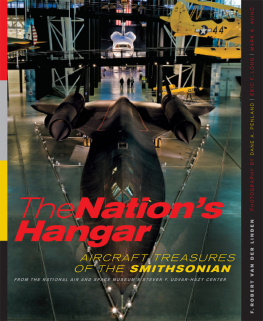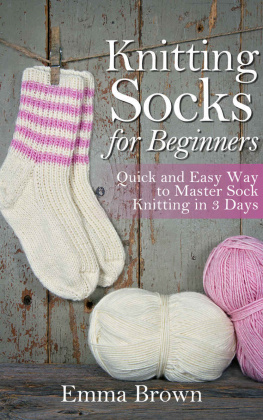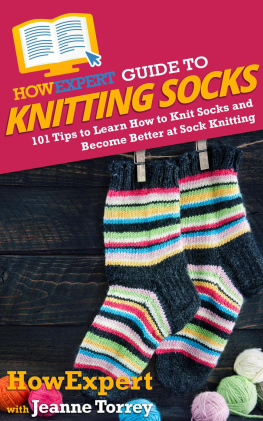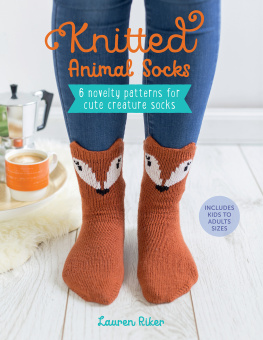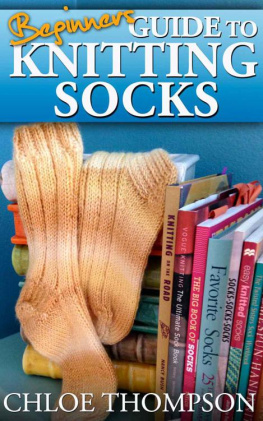Op-Art
SOCKS
CREATIVE
EFFECTS
IN SOCK
KNITTING
STEPHANIE VAN DER LINDEN

Contents
Patterns
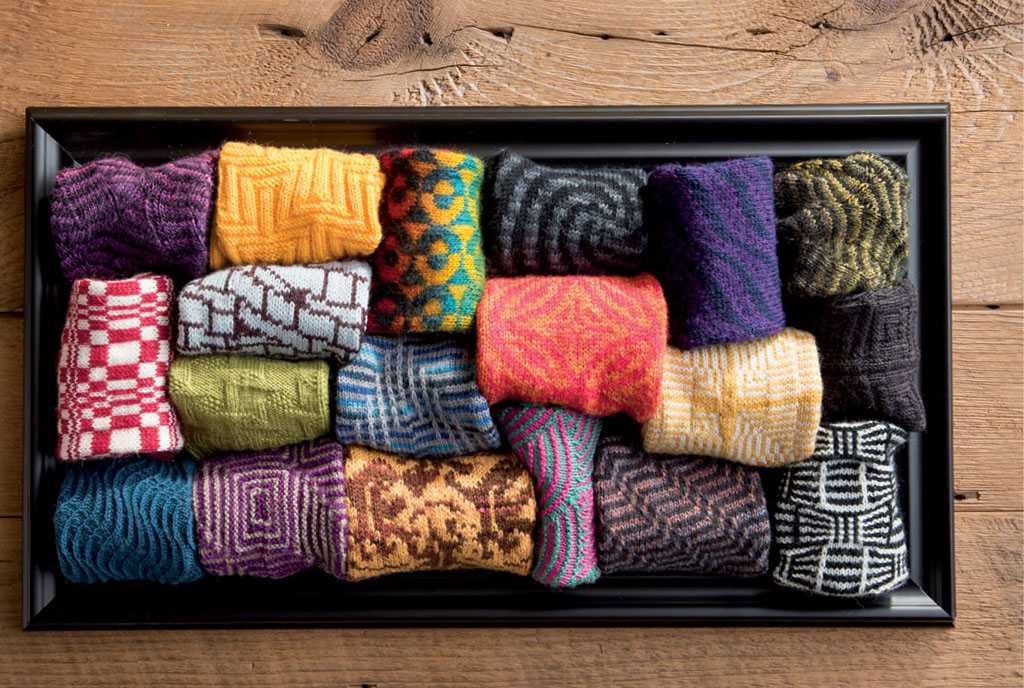
Introduction
Knitted socks are small projects that warm ones feet and make welcome gifts. What is particular about designing knitted socks is that the stitch and color patterns must fit in rounds and must accommodate the particular construction. I like designing socks of all types, but I particularly like the challenge of designing socks that fit within themes. The optical art or op-art movement of the 1960s inspired the patterns in this book.
Derived from the German Bauhaus School founded by Walter Gropius in 1919, op art was identified in 1964 as a movement in the visual arts that emphasizes the psychological and physiological conditions of visual experience. Op art explores visual perception through the illusion of movement, much of which is unsettling to the viewer and difficult for the eye to resolve. Its closely related to research on how we see things and how we interpret what we see. Op-art paintings and drawings intentionally break symmetries and regularities to create impressions of depth (a third dimension) or dynamics (movement, flashing, vibration) by optical illusion.
Many of the best-known examples of op art are presented in black and white and involve tiles or lines used in such a way that the difference between the figure and the background is obscured. The result is a seemingly volatile surface without a fixed reference point. In addition to depth and dynamics, these black-and-white works create lingering after-images or, at times, the illusion of color. Other works use contrasting colorsranging from tone-on-tone to complementary colorsto stir visual impressions.
My approach to sock design is influenced by my background in mathematics, engineering, and chemistry. Im also attracted to the Bauhaus tenet combining form and function. For the designs in this book, I interpreted classic op-art patterns in different knitting techniques to create socks that are both appealing and practical. Through the use of simple knit and purl stitches and stranded colorwork to represent blocks, lines, and angles, these socks are eye-catching explorations of depth, vibration, and reversals.
Before You Begin
To ensure the greatest enjoyment and success when you knit the socks in this collection, I have adopted a few techniques that are worth mentioning here.
NEEDLE SIZE
Because socks fit best if they have negative ease (the stitches are stretched when worn), those knitted with textured patterns are best worked at denser gauges than normally recommended for a particular yarn. This is why many of the socks in this collection are worked on the smallest recommended needle size.
STRANDED COLORWORK
A common challenge with stranded colorwork is maintaining proper tension on the yarn that floats across the back of the work, especially at the transitions between needles when working socks in rounds. If you turn the sock inside out, you can force the floats to follow a slightly longer path around the outside of the sock, which can help ensure that they are loose enough to allow the stitches to maintain the necessary stretch. To begin, cast on and work the first two rounds of the cuff as usual. Then turn the cuff inside out so that the right side of the knitting faces the inside of the circle. Everything will remain the same, but youll knit on the back (or far) side of the circle instead of the front. When it comes time to work a heel flap in rows, turn the knitting around and work on just the heel-flap stitches; once you rejoin for working in rounds, turn the work inside out again to work on the far side.

For most of the socks in this book that involve stranded colorwork, the gusset stitches are picked up with just one color while the instep stitches are worked with two. To avoid having to cut the working yarns (and potentially interrupt the established color sequence), before you cast on stitches for the sock, cut a length of yarn to be used for picking up the gusset stitches. Use this length when it comes time to pick up and knit stitches along the right side of the heel flap (the side that usually would be worked last), then use the attached yarn to work across the heel stitches and to pick up and knit stitches along the left side of heel flap. Youll then have both working yarns in position to work in rounds; the rounds will begin between the sole and instep stitches, instead at the center of the sole.
FOLLOWING CHARTS
Charts are a necessity for following op-art patterns in knitting. However, because by their nature the patterns cause visual movement, it can be difficult to follow the individual rows. To help keep track of your place, especially on large charts, make an enlarged photocopy of the chart (making a separate copy for each sock), then cross out each row as you complete it.
I find that its easiest to work charted patterns if all of the stitches for a long section or complete repeat of the chart are on a single needle instead of split between two needles. This is why a number of my patterns call for working with two circular needles instead of four or five double-pointed ones. Working with two circular needles has the added advantage of minimizing the number of breaks between needles where ladders of loose stitches are likely to occur.
I hope that these hints will help you have as much fun knitting these socks as I had designing them!
Stephanie van der Linden

Fibonacci
With a chessboard as its basis, a spatial impression of the two-dimensional original can be generated by symmetric compression and stretching in the order of the Fibonacci sequence. Leonardo da Pisa (a.k.a., Fibonacci) introduced the sequence in 1202, although it has earlier roots in Indian mathematics. The Fibonacci sequence begins 1, 1, 2, 3, 5, 8, with the last two numbers always added together to produce the next number. The sequence is intimately connected with the golden ratio (in which the sum of the smaller and larger quantity is equal to the ratio of the larger quantity to the smaller one). Many artists and architects have proportioned their works to approximate the golden ratio, especially in the form of the golden rectangle, which can be found several times in the chart pattern for the socks shown here.
Named for the Fibonacci principle, these socks feature this mathematic principle in two colorsred and white. Theyre knitted in the round with two circular needles to minimize the number of breaks between needles.

FINISHED SIZE
About 814" (21 cm) foot circumference and 934 (1012)" (25 [26.5] cm) foot length from back of heel to tip of toe.
To fit U.S. womens shoe sizes 89 (1011); European shoe sizes 3941 (4244).
Socks shown measure 1012" (26.5 cm) in foot length.
YARN
Fingering weight (Super Fine #1).


